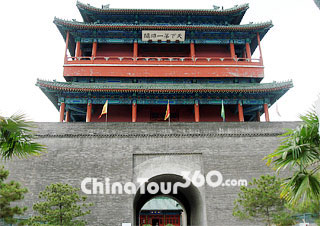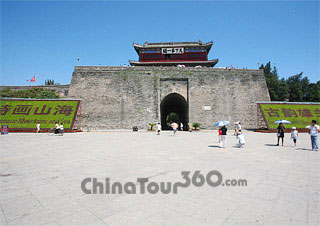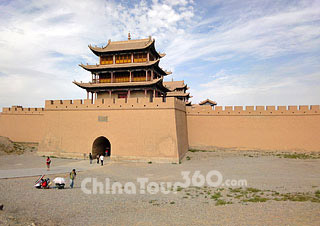 Juyongguan
Juyongguan Shanhaiguan
Shanhaiguan Guguan in Yangquan, Shanxi
Guguan in Yangquan, Shanxi Jiayuguan
Jiayuguan
Passes are a significant aspect of the Great Wall defense system built at places of strategic importance, such as on mountain ridges, at deep valleys, and at the strategic passages near mountains and water, or constructed in crucial points where soldiers can control rivers, seas or bays in defense against encroaching enemies. The small towns built at each pass are the key defensive points along the wall, and are directly related to the safety of their nearby areas.
The earliest ones appeared in the Xia (21st - 17th Century BC), Shang (17th - 11th Century BC) and Western Zhou (11th Century - 771BC) Dynasties, when they were positioned at borders to collect taxes. They became a part of the Great Wall in the Eastern Zhou Dynasty (770BC - 221 BC). Later in the Qin (221BC - 207BC) and Han (206 BC - 220 AD) Dynasties, small towns were built near walls at every 10 li (3.1 miles). The small towns were called Zhang or Wu in the Han Dynasty, and were used to station garrisons or troops and peasants who were developing the surrounding wasteland for farming. The Tang Dynasty (618 - 907) did not rebuild or renovate the walls, but did much construction work to the passes and fortresses built by previous dynasties. The construction reached its peak in the Ming Dynasty (1368 - 1644). Many were newly built and renovations were done to the old ones on a large scale. Those of the Ming Dynasty fell into several categories, such as Zhenchen, Weicheng, Lucheng, Guancheng, and Baocheng, among which Guancheng and Baocheng were the most representative constructions of Ming Dynasty Great Walls.
![]() Famous Passes:
Famous Passes:
Shanhaiguan Jiayuguan Juyongguan Huangyaguan Shuiguan
Yumenguan Yangguan Yanmenguan Niangziguan Pianguan Zijingguan
![]() A complete pass is comprised of many parts:
A complete pass is comprised of many parts:
![]() Wall: The walls are usually strong and high (with an average height of 10 meters). They are covered by huge bricks outside, and filled with earth and gravel. They are about 4 or 5 meters wide on top, which allows 4 horses standing head to tail. Madao (a ramp for horses to walk on) and stairs for ascending and descending the wall are also constructed. Crenellations for watching and shooting are built on the outer wall while Nüqiang or Yüqiang for protecting the people and the horses from falling down the wall is built on the inner wall.
Wall: The walls are usually strong and high (with an average height of 10 meters). They are covered by huge bricks outside, and filled with earth and gravel. They are about 4 or 5 meters wide on top, which allows 4 horses standing head to tail. Madao (a ramp for horses to walk on) and stairs for ascending and descending the wall are also constructed. Crenellations for watching and shooting are built on the outer wall while Nüqiang or Yüqiang for protecting the people and the horses from falling down the wall is built on the inner wall.
![]() Gate: A gate is for entering and exiting. Some gates are installed with hidden weapons.
Gate: A gate is for entering and exiting. Some gates are installed with hidden weapons.
![]() Gate Tower: A gate tower is the tower built on the gate, which is responsible for the observation and command giving in a war. Built of wood or bricks and wood, the tower can have one, two or three storeys. Some towers are decorated with fancy roofs and vivid wood or stone carvings, and some have carved beams and painted columns. Therefore, a gate tower of the Great Wall is not only useful in wars, but also a magnificent architecture of high artistic value. Famous gate towers are the First Pass under Heaven of the Shanhaiguan, as well as the Guanghua Gate and Rouyuan Gate of the Jiayuguan.
Gate Tower: A gate tower is the tower built on the gate, which is responsible for the observation and command giving in a war. Built of wood or bricks and wood, the tower can have one, two or three storeys. Some towers are decorated with fancy roofs and vivid wood or stone carvings, and some have carved beams and painted columns. Therefore, a gate tower of the Great Wall is not only useful in wars, but also a magnificent architecture of high artistic value. Famous gate towers are the First Pass under Heaven of the Shanhaiguan, as well as the Guanghua Gate and Rouyuan Gate of the Jiayuguan.
![]() Wengcheng: Also named Yuecheng, it is a "Π” shaped wall built outside the wall to protect the Gate. The Wengcheng resembles a huge jar, which is Weng in Chinese, hence the name. The Wengcheng also has its own gate, which is at right angles to the main Gate. Under the protection of the Wengcheng, enemies can not attack the Gate directly if they broke through the Wengcheng Gate. At the same time, when enemies rush into the Wengcheng, they are captured like the turtle in the jar.
Wengcheng: Also named Yuecheng, it is a "Π” shaped wall built outside the wall to protect the Gate. The Wengcheng resembles a huge jar, which is Weng in Chinese, hence the name. The Wengcheng also has its own gate, which is at right angles to the main Gate. Under the protection of the Wengcheng, enemies can not attack the Gate directly if they broke through the Wengcheng Gate. At the same time, when enemies rush into the Wengcheng, they are captured like the turtle in the jar.
![]() Luocheng: Luocheng is a "Π” shaped wall outside the Wengcheng. It is a long wall that covers both the Wengcheng and a part of the Wall of the pass. On the wall of the Luocheng, gate towers are also built, which then can work as watch towers as well as command posts. To strengthen the defensive function, arrow towers for observation are constructed at each end of the wall.
Luocheng: Luocheng is a "Π” shaped wall outside the Wengcheng. It is a long wall that covers both the Wengcheng and a part of the Wall of the pass. On the wall of the Luocheng, gate towers are also built, which then can work as watch towers as well as command posts. To strengthen the defensive function, arrow towers for observation are constructed at each end of the wall.
![]() Moat: A moat is dug around some pass.
Moat: A moat is dug around some pass.







